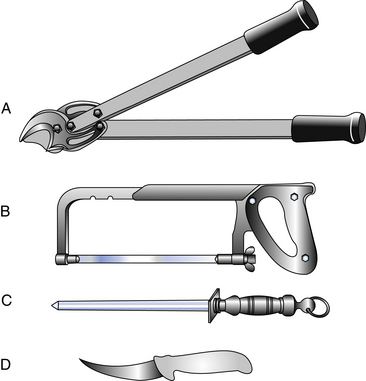CHAPTER 13 Field Necropsy of the Horse
For many veterinarians, especially those working in equine and food-animal medicine, the prospect of performing a necropsy in the field, where carcass handling equipment and support personnel are not available, can be a daunting prospect. Although it is common for individuals to undertake a “cosmetic” postmortem examination (i.e., opening the carcass enough to extract the organ system(s) of interest to the case), it is less common for veterinarians to perform a complete necropsy on the animal. In contrast to cosmetic postmortem examinations, a complete necropsy is performed in an effort to systematically examine the entire carcass. This process, though more time consuming and laborious, will greatly enhance the chances of arriving at a diagnosis and provides a more complete understanding of the case.
PREPARING TO PERFORM THE NECROPSY
Materials Needed to Perform the Field Necropsy
The list of essential tools and materials necessary to perform a field necropsy is relatively short and equipment is easily acquired through a variety of retail establishments that carry landscape supplies and tools (Figure 13-1, Box 13-1). A durable, high-quality necropsy knife (deboning knife) is the one indispensable tool for performing a necropsy; the knife should be purchased from a company that sells knives manufactured for such purposes. It is essential that the person performing the necropsy take the necessary precautions to protect against potential contamination from the carcass by wearing protective clothing, gloves, and eyewear.
Choosing the Site for the Field Necropsy
The number of people involved with the necropsy should be kept to a minimum and should not involve individuals involved in the daily care of other animals on the property. This will lessen the likelihood of spreading potentially infectious diseases to other horses on the property.




